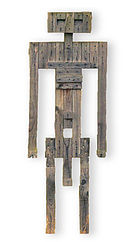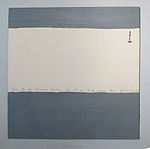Jörg-Werner Schmidt


Jörg-Werner Schmidt (* 1941 in Schneidemühl ; † 2010 ) was a German installation artist and painter . He had studios in Mittelhof and in Camp Reinsehlen .
Live and act

Jörg-Werner Schmidt's father was killed on D-Day in Normandy during the Second World War as a soldier during the Allied landing . Due to the early loss of his homeland Pomerania as a result of the war, Schmidt saw himself as emotionally and spatially uprooted. As a child he lived with his family in Unterlüß for a while . He later worked in the commercial sector. He was married twice and had three daughters. After many years of professional activity, Jörg-Werner Schmidt sold his company in order to pursue his artistic inclinations from 1990 onwards. First he opened a gallery in his home town of Tutzing , but increasingly devoted himself to his own artistic projects. In 1991 he was the first sculpture to create a slat man. At this time a phase of intensive artistic work began. His oeuvre includes paintings, sculptures as well as installations and land art .
In Jesteburg , which Schmidt had got to know on a vacation trip, he was given a workshop in 1991 to prepare an art exhibition. In 1991 he set up a studio and an art meeting place in Mittelhof in Mecklenburg . His first wife Barbara ran a painting school and restaurant there until 2007. 2001 and 2002, Schmidt received stipends in the Charterhouse in Switzerland. In 2004 he moved into a studio on the former British military site of Camp Reinsehlen in the Lüneburg Heath , which he set up in a former horse stable . On the large area, which has already been abandoned by the military, he opened up an art space by displaying his works.
material
Jörg-Werner Schmidt's preferred material was wood , especially untreated roof battens made of pine, spruce and larch in the size 2.5 × 5 cm. He had the wood from the respective region cut to size in sawmills for his purposes. The intensive relationship with wood was based on the fact that he had played as a child on his grandfather's sawmill in Pomerania and he remembered the sensual experiences, such as smells and noises.
Jörg-Werner Schmidt later added glass , acrylic and steel as additional materials, which were used on cardboard and wood.
Works
The works of art by Jörg-Werner Schmidt are privately owned or some of them can still be found in the places where they were set up by him. This is the case in numerous places in Germany. Most of the works on the former military site of Camp Reinsehlen are on public display. His studio there, which he ran until his death in 2010, was converted into a conference venue in 2012.
Slat man

At the beginning of his artistic career, Jörg-Werner Schmidt developed the figure of the slat man. These are flat figures with life-size human contours. As in most of his works, Schmidt used roof battens made of untreated softwood. The individual slats are connected to one another with nails, screws and glue.
Schmidt created the first slat man in 1991 in the basement of his house in Tutzing. A short time later, six more sculptures of this kind were created. He exhibited the group of seven slat people in Tutzing and Munich . In 1997 he enlarged the group of slat people to over 100 wooden sculptures, which could be seen in 22 locations by 2009. According to Schmidt, the characters only develop their strongest artistic effect as a society in their multitude . In the course of the exhibition years, the number of figures was reduced by the fact that some remained at the installation sites or were destroyed.
Exhibition places of the pale people

Installations with the wooden sculpture of the slat man as society in varying numbers took place in:
|
|
Rows of chairs
Rows of chairs were another of the artist's main themes. These are installations with joined or individually standing chairs made of wooden slats with high backs, reminiscent of a throne . With the object, the artist reflected the occidental cultural history of the chair. It offers people support and support in various activities such as waiting, governing, eating, writing and reading. In the Mecklenburg village of Mittelhof, he set up a circle of chairs with twelve individual chairs, in the center of which a linden tree was planted. In 1996, Schmidt placed a circle of 117 chairs in the park of Blücher Castle in Göhren-Lebbin . The installation was dismantled in 1998 due to the creation of the Land Fleesensee tourist facility and part of it was relocated to Wrodow Castle and Camp Reinsehlen.
Buckling pyramid
The kink pyramid set up in Camp Reinsehlen in 2007 was based on the model of the kink pyramid from Dahshur . It consists of wooden slats for which 50 Douglas fir and larch tree trunks were felled from the Sellhorn Forestry Office near Bispingen . The square base of the pyramid has a side length of 10.8 meters. At a height of 2.2 meters, the 5.2 meter high pyramid bends inward. Originally, a warm glow of light penetrated through the spaces between the slats of the pyramid and a sound installation gave off a sound of different strengths. In 2011 these functions were no longer in operation. Originally Schmidt had planned an underground art gallery under the pyramid, which was not implemented for reasons of cost.
Gaps
Jörg-Werner Schmidt's first public work in Camp Reinsehlen was the picture in- between spaces on the transformer building . Since it is located roughly in the middle of the large outdoor area, it can be seen from afar. The picture consists of 13 cm wide red and 7 cm wide white stripes on the 6 meter high and 9 meter wide building facade. The spaces between the stripes are supposed to symbolize phases of life such as work and vacation, health and illness. From a distance, the stripes create optical illusions so that they appear equally wide. In sunshine and warmth, the surface shimmers from a distance and appears as a uniform surface in pink color.
painting
Jörg-Werner Schmidt's two-dimensional works and painting are characterized by their reduction to color, line and surface. He benefited from his experience with the material of the wooden slat. In terms of geometric elements, he mainly used the symbol of the cross as the intersection of surfaces and lines.
Exhibitions
- 1997 Jesteburg : Art week on the subject of luxury, installation of 25 open boxes made of roof battens and roof battens joined together to form a sidewalk, as well as "masks" in the form of 6 sculptures made of roof battens
- 1998 Schwerin : Installation of a society with 80 people in front of the north / LB
- 2000 Jesteburg: Art week on the topic of romanticism, installation Romantic society with 28 slat people coming from the roof of the building onto the street.
- 2002 Hessiale in Gießen : The power of symbols with a circle of chairs and a labyrinth around a tree
- 2003 International horticultural exhibition in Rostock: Land-Art project " Don Quijote "
- 2005 Camp Reinsehlen: Gaps as a picture on the transformer house
- 2005 St. Pauli Elbtunnel in Hamburg: art installation opinion picture - I miss in Germany ... with 101 slat people
- 2006 3rd Swiss Triennial of Sculpture in Bad Ragaz and Vaduz : A row of chairs
- 2007 Camp Reinsehlen: Buckling pyramid
- 2008 International Sculpture Exhibition in Cottesloe / Western Australia : Installation Society with Lattenmenschen
- 2009 International Sculpture Exhibition on Aarhus Beach : Installation Society with 77 Slat People
literature
- Jörg-Werner Schmidt: Journeys through the art of Jörg-Werner Schmidt , part one, work on the art week Jesteburg, 2001, Hamburg
- Werner Köster: The history of "Camp Reinsehlen". From the Fintau spring to the poor grassland , 2002, Schneverdingen
- Jörg-Werner Schmidt: Journeys through the art of Jörg-Werner Schmidt , part two, five stations, 2003, Altenburg
Web links
- Artist's website
- Website of the artist on the Lattenmenschen
- Photo by Jörg-Werner Schmidt with slat men
- Photo of a group of slender people in the open space of Camp Reinsehlen
Individual evidence
- ↑ Heidekurier of April 18, 2007 (pdf, 9 MB)
- ↑ Inauguration of the bent pyramid ( page no longer accessible , search in web archives ) Info: The link was automatically marked as defective. Please check the link according to the instructions and then remove this notice.
- ↑ Exhibition catalog (pdf, 5 MB)
- ↑ Slat Humans Sculptures by the sea from 6-18 March 2008
- ↑ From Sydney to Aarhus - Art on the Beach ( Memento of the original from July 3, 2009 in the Internet Archive ) Info: The archive link has been inserted automatically and has not yet been checked. Please check the original and archive link according to the instructions and then remove this notice.
| personal data | |
|---|---|
| SURNAME | Schmidt, Jörg-Werner |
| BRIEF DESCRIPTION | German installation artist and painter |
| DATE OF BIRTH | 1941 |
| PLACE OF BIRTH | Schneidemühl |
| DATE OF DEATH | 2010 |









